In the realm of electronics and electrical engineering, choosing the right component for switching and controlling circuits is crucial. Two of the most commonly used devices for these purposes are Metal-Oxide-Semiconductor Field-Effect Transistors (MOSFETs) and relays. Each of these components has distinct characteristics and advantages that make them suitable for specific applications.
MOSFETs, known for their fast switching speeds and high efficiency, are predominantly used in digital circuits and low-power applications. Relays, on the other hand, excel in providing robust electrical isolation and handling high voltage and current loads. Understanding the differences in their working principles, applications, and advantages is essential for making an informed decision on which to use in a given scenario.
What is MOSFET
A Metal-Oxide-Semiconductor Field-Effect Transistor (MOSFET) is a type of transistor used to amplify or switch electronic signals. It features an insulated gate, where the applied voltage controls the device's conductivity. MOSFETs are preferred over bipolar junction transistors (BJTs) because they require almost no input current to control the output current.
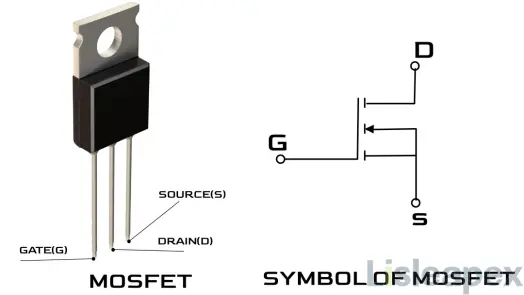
MOSFETs can be made using either p-type or n-type semiconductors, and they are essential in digital circuits, often found in large numbers within memory chips and microprocessors. Complementary pairs of MOSFETs are used in CMOS logic circuits, which consume very little power. Despite the name, modern MOSFETs often use polysilicon gates and various dielectrics instead of metal and oxide.
Types of MOSFET
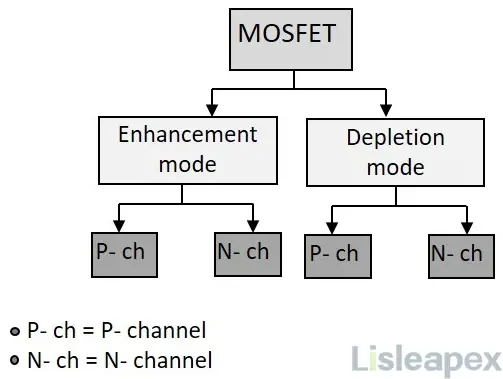
P-Channel MOSFET
In P-Channel MOSFETs, the source and drain are heavily doped p+ regions, and the substrate is n-type. Current flows due to the movement of holes. A negative gate voltage repels electrons beneath the oxide layer, creating a channel rich in holes.
N-Channel MOSFET
In N-Channel MOSFETs, the source and drain are heavily doped n+ regions, and the substrate is p-type. Current flows due to the movement of electrons. A positive gate voltage repels holes beneath the oxide layer, creating a channel rich in electrons.
What is Relay
A relay is an electrically operated switch designed to control a circuit using a low-power signal. It has input terminals for control signals and output terminals for the switch's operating contacts. Relays can have various contact forms, including make, break, or a combination of both.
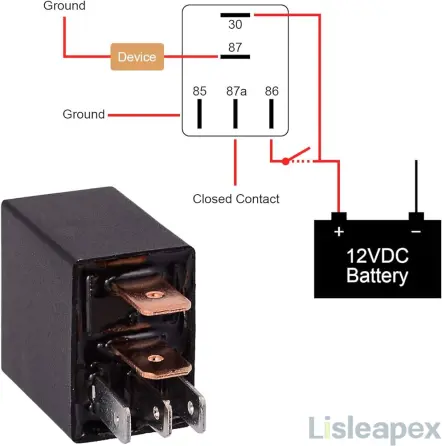
Relays are crucial when a low-power signal needs to control a larger circuit or when one signal needs to manage multiple circuits. Initially, relays were used in long-distance telegraph systems as signal repeaters, transmitting signals from one circuit to another. They also played significant roles in telephone exchanges and early computers for logical operations.
Types of Relay
Some important types of relays include:
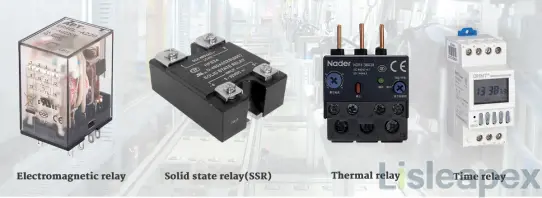
- Electromechanical Relays
- Solid State Relays
- Latching Relays
- Reed Relays
- Time Delay Relays
- Thermal Relays
- Automotive Relays
- Safety Relays
Electromechanical Relays
Electromechanical relays use an electromagnet to mechanically switch contacts open or closed. When an electrical current passes through the coil, it generates a magnetic field that moves an armature, which either makes or breaks a connection. These relays are known for their robustness and are widely used in various applications due to their ability to handle high currents and voltages. They offer clear visual and audible indications of switching, making them useful in both industrial and consumer electronics.
Solid State Relays
Solid state relays (SSRs) utilize semiconductor devices to perform switching without moving parts. They rely on properties of semiconductor materials to control the flow of current. SSRs offer several advantages over electromechanical relays, including faster switching speeds, longer operational life due to the lack of mechanical wear, and greater resistance to shock and vibration. They are ideal for applications requiring silent operation and where reliability and longevity are critical, such as in computer peripherals and industrial automation.
MOSFET vs Relay: Working Principle and Task
MOSFET: Working Principle and Task
Working Principle
A MOSFET (Metal-Oxide-Semiconductor Field-Effect Transistor) is a type of transistor that uses voltage to control the flow of current. When a voltage is applied to the gate terminal, it creates an electric field that forms a conductive channel between the source and drain terminals, allowing current to pass through. This operation involves no moving parts, making MOSFETs efficient and reliable for switching and amplification tasks.
Task
MOSFETs are used to switch and amplify electronic signals. They are highly efficient for applications requiring rapid switching and precise control, such as in computer processors, power management circuits, and RF signal processing. Due to their solid-state nature, MOSFETs have a long lifespan and can operate at high speeds with low power consumption.
Relay: Working Principle and Task
Working Principle
A relay is an electromechanical switch that uses an electromagnetic coil to operate. When a small current flows through the coil, it generates a magnetic field that moves a mechanical switch, either opening or closing a circuit. This movement physically connects or disconnects the electrical contacts, providing clear isolation between the control signal and the load.
Task
Relays are used to control high-power circuits with a low-power signal. They are commonly found in applications where electrical isolation is crucial, such as in industrial machinery, automotive systems, and telecommunications. Relays are robust and can handle high voltages and currents, but their mechanical parts can wear out over time, making them slower and less durable than solid-state devices like MOSFETs.
MOSFET vs Relay: Detailed Parameter Comparison
1. Switching Speed

Relay:
Relays have slower switching times, typically in milliseconds, due to the mechanical movement of metal contacts during operation. This physical action inherently limits the speed at which relays can switch.
MOSFET:
MOSFETs switch extremely quickly, often in nanoseconds, as they operate electronically without any moving parts. The changes in electric fields within the device enable rapid switching, making MOSFETs ideal for high-speed applications.
2. Trigger Current
Relay:
Electromechanical relays typically require a trigger current of at least 5 mA to operate, making them less suitable for low-power applications where minimal current consumption is desired.
MOSFET:
MOSFET relays can be triggered with a much lower current, sometimes as little as 0.2 mA. This makes them more efficient for battery-powered applications and prevents mains overload when multiple relays are used.
3. Isolation
Relay:
Relays provide excellent electrical isolation between the input (control side) and output circuits, as these two sides are mechanically coupled but electrically isolated.
MOSFET:
MOSFETs do not offer inherent electrical isolation between the input and output circuits. This lack of isolation may be a disadvantage in applications where electrical isolation is necessary.
4. Power Consumption
Relay:
Relays typically consume more power than MOSFETs because they require current to hold the relay coil in place to maintain its state.
MOSFET:
MOSFETs only require power during switching operations, and once switched, no further power is needed to maintain their state. This results in lower overall power consumption compared to relays.
5. Power Efficiency
Relay:
Relays have moving parts and may generate heat during operation, resulting in potentially lower power efficiency, especially in high-power applications.
MOSFET:
When used correctly, MOSFETs can be very efficient with minimal power losses. They operate silently and do not generate mechanical noise, contributing to their overall power efficiency.
6. Noise
Relay:
Due to the physical contacts involved in operation, relays can generate electrical noise (arcing) and mechanical noise (movement of parts), which may be undesirable in certain applications.
MOSFET:
MOSFETs, being solid-state devices with no moving parts, operate silently and do not create any mechanical noise or arcing, making them suitable for noise-sensitive applications.
7. Heat Dissipation
Relay:
Relays generally do not generate significant amounts of heat during operation due to their on/off switching nature. However, some heat may be generated due to coil resistance when the relay is energized.
MOSFET:
MOSFETs can generate heat, especially when operating in their linear region or when conducting high currents. Proper heat dissipation methods such as heatsinks or fans may be required to prevent overheating and ensure reliable operation.
MOSFET vs Relay: Application
MOSFET Applications
MOSFETs are ideal for circuits that manage small current loads due to their fast response times and low power consumption. They are commonly used in applications such as:
- LED Control: MOSFETs efficiently switch LEDs on and off with precise control, enabling dimming functions and rapid switching in lighting applications.
- Motor Control: In small motors, MOSFETs provide precise speed and direction control with high efficiency, suitable for applications like drones, robotics, and small appliances.
- Power Management: MOSFETs are extensively used in power supplies and voltage regulators to ensure efficient power distribution in electronic devices.
- Signal Amplification: Due to their high input impedance and fast switching capabilities, MOSFETs are used in audio amplifiers and RF amplifiers to enhance signal strength without significant power loss.
Relay Applications
Relays are better suited for controlling large current loads due to their ability to withstand high voltages and currents. They are commonly used in applications such as:
- Household Appliances: Relays control the high power requirements of devices like air conditioners, refrigerators, and washing machines by isolating the low-power control circuit from the high-power load.
- Automotive Systems: In vehicles, relays manage the switching of headlights, starter motors, and fuel pumps, handling the high currents involved in these systems.
- Industrial Machinery: Relays are used to control heavy-duty industrial equipment, providing reliable operation under high load conditions and ensuring safety through electrical isolation.
- Telecommunications: Relays in telecommunications equipment manage signal routing and switching, ensuring stable connections and signal integrity.
MOSFET vs Relay: Lifespan
Relay Lifespan
Relays have a finite lifespan due to the mechanical movement involved in their operation. Over time, the components experience wear and tear, particularly at the contact points, where friction and arcing occur during switching. This mechanical stress can lead to degradation and eventual failure of the relay, limiting its lifespan.
MOSFET Lifespan
In contrast, MOSFETs are solid-state devices with no moving parts or physical contacts. Because they rely on semiconductor technology for operation, MOSFETs generally have longer lifespans than relays. Under normal operating conditions, MOSFETs experience minimal wear and degradation, resulting in increased reliability and longevity compared to relays.
MOSFET vs Relay: Price
Currently, electromechanical relays are generally more affordable than MOSFET models. Their lower initial cost makes them attractive for budget-conscious projects and applications where cost is a primary consideration.
Cost-of-Ownership Analysis
However, when considering the total cost of ownership, including maintenance expenses, relays may become more expensive in the long run, particularly in applications where frequent maintenance or replacement is required due to wear and tear on mechanical components. This additional cost factor should be taken into account in cost-of-ownership analyses, especially for applications where reliability and longevity are essential considerations.
MOSFET vs Relay: Advantages and Disadvantages
MOSFET Advantages and Disadvantages
Advantages:
Fast Switching Speed: MOSFETs switch rapidly, often in nanoseconds, due to their electronic operation without any moving parts.
Low Power Consumption: MOSFETs consume minimal power during switching operations and require no power to maintain their state once switched.
High Efficiency: When used correctly, MOSFETs can be very efficient, with minimal power losses.
Silent Operation: MOSFETs operate silently without generating any mechanical noise.
Long Lifespan: Solid-state construction results in longer lifespans compared to relays, with minimal wear and degradation.
Disadvantages:
Lack of Electrical Isolation: MOSFETs do not provide inherent electrical isolation between input and output circuits, which may be a disadvantage in certain applications.
Heat Dissipation: MOSFETs can generate heat, especially when operating in their linear region or conducting high currents, requiring proper heat dissipation measures.
Complex Drive Circuitry: MOSFETs may require complex drive circuitry for precise control and protection, adding complexity to the overall system design.
Relay Advantages and Disadvantages
Advantages:
Excellent Electrical Isolation: Relays provide excellent electrical isolation between input and output circuits, making them suitable for applications requiring isolation.
High Voltage and Current Handling: Relays can handle high voltages and currents, making them ideal for high-power applications.
Simple Drive Circuitry: Relays typically require simpler drive circuitry compared to MOSFETs, making them easier to implement in some applications.
Mechanical Robustness: Relays are mechanically robust and can withstand harsh environmental conditions and high levels of shock and vibration.
Disadvantages:
Slow Switching Speed: Relays have slower switching times, typically in milliseconds, due to the mechanical movement of metal contacts.
High Power Consumption: Relays consume more power than MOSFETs, especially during coil energization.
Limited Lifespan: Relays have a finite lifespan due to mechanical wear and degradation, leading to eventual failure.
Noise Generation: Relays can generate electrical and mechanical noise during operation, which may be undesirable in noise-sensitive applications.
Similarities between MOSFET and Relay
Both MOSFETs and relays serve as essential components for controlling electrical circuits. They are used for signal switching, provide isolation and protection, and are highly versatile across various applications. Despite their differences in operation—MOSFETs being solid-state devices and relays being electromechanical—their roles in efficiency, integration, reliability, and safety in power management highlight their indispensable nature in modern electronics and electrical engineering.
Differences between MOSFET and Relay
MOSFETs and relays are crucial for controlling electrical circuits, but they operate on fundamentally different principles and are suited for different applications. MOSFETs, being solid-state devices, offer rapid switching, high efficiency, and a long lifespan. In contrast, relays, with their electromechanical operation, provide robust electrical isolation and the ability to handle high voltages and currents but have slower switching speeds and limited durability due to mechanical wear.
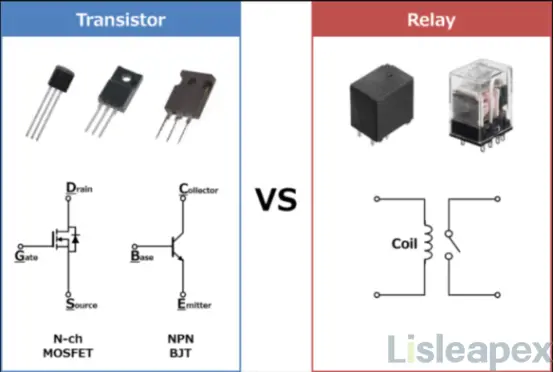
|
Characteristic |
Relay |
MOSFET |
|
Principle of Operation |
Electromechanical operation: Uses an electromagnetic coil to open/close mechanical contacts. |
Solid-state operation: Controls current flow using electric fields (no moving parts). |
|
Switching Speed |
Slow (milliseconds) due to mechanical movement. |
Fast (nanoseconds to microseconds) due to electronic operation. |
|
Lifetime/Durability |
Limited by mechanical wear and tear on the contacts, leading to eventual failure after a certain number of switching cycles. |
Virtually unlimited switching cycles under normal conditions; limited mainly by thermal and electrical stress. |
|
Electrical Isolation |
Provides good isolation between control and load circuits because they are physically separate systems. |
Does not inherently provide electrical isolation; additional components/circuits needed if required. |
|
Noise Generation |
Can generate clicking noise during operation due to its electromechanical nature. |
Silent during operation as it's a solid-state device. |
|
Heat Dissipation |
Mild heat generation; usually does not require heatsinks or fans. |
Can generate significant heat depending on operating conditions; may need heatsinks/fans for cooling. |
|
Trigger Current |
Typically requires a higher trigger current (at least 5 mA). |
Can be triggered with a very low current (as little as 0.2 mA). |
|
Power Consumption |
Consumes more power, especially during coil energization to maintain state. |
Consumes minimal power during switching operations; no power needed to maintain state once switched. |
|
Power Efficiency |
Potentially lower power efficiency due to heat generation and mechanical wear. |
Highly efficient with minimal power losses when used correctly. |
|
Applications |
Better suited for controlling large current loads in household appliances, automotive systems, industrial machinery, and telecommunications. |
Ideal for circuits managing small current loads, LED control, motor control, power management, and signal amplification. |
|
Lifespan |
Finite lifespan due to mechanical wear and tear on moving parts. |
Longer lifespan with minimal wear and degradation due to solid-state construction. |
|
Price |
Lower initial cost, but higher maintenance and replacement costs over time due to mechanical wear. |
Generally more expensive initially, but lower total cost of ownership due to longevity and efficiency. |
How to Choose between MOSFET and Relay
Choosing between a MOSFET and a relay involves considering factors such as switching speed, load type, electrical isolation, noise generation, power consumption, durability, heat dissipation, and cost. MOSFETs are ideal for applications requiring high-speed switching, low power consumption, and silent operation. They excel in managing small to medium current loads with precision, making them suitable for use in computer processors, power management circuits, and LED control. However, MOSFETs do not inherently provide electrical isolation and may require additional circuits for this purpose.
On the other hand, relays are well-suited for handling high current and high voltage loads, offering excellent electrical isolation between control and load circuits. They are commonly used in household appliances, automotive systems, and industrial machinery where robustness and the ability to manage high power are crucial. While relays generate noise and have a shorter lifespan due to mechanical wear, their lower initial cost and simpler drive circuitry can make them a cost-effective choice for specific applications where switching speed and silent operation are not primary concerns.
Conclusion
In conclusion, both MOSFETs and relays are indispensable components in modern electronics, each offering unique benefits tailored to different requirements. MOSFETs are ideal for high-speed, low-power, and precision applications, where efficiency and silent operation are paramount. Conversely, relays are better suited for high-power, high-voltage tasks requiring robust electrical isolation and mechanical resilience.
The decision to use a MOSFET or a relay depends on the specific needs of the application, including factors such as switching speed, power consumption, durability, and cost. By carefully considering these factors, engineers can leverage the strengths of each component to design effective and reliable electronic systems.
Further Reading:
Finfet vs Mosfet: What are Differences and Which is Better PDF
FAQ
-
When should I use a MOSFET instead of a relay?
Use a MOSFET when you need fast switching speeds, higher efficiency, silent operation, and when space and reliability are important. MOSFETs are ideal for high-frequency applications, such as in power supplies and motor controllers.
-
When should I use a relay instead of a MOSFET?
Use a relay when you need to switch high voltages and currents, require electrical isolation, or need to control AC loads. Relays are suitable for applications such as home automation, automotive, and industrial control systems.
-
Which is more power-efficient, a MOSFET or a relay?
MOSFETs are generally more power-efficient than relays because they have lower on-state resistance and no mechanical parts, leading to less energy loss.
-
Can MOSFETs and relays be used together in the same circuit?
Yes, MOSFETs and relays can be used together in the same circuit. For example, a MOSFET can be used to drive a relay coil, allowing the control of high-power loads with the benefits of both devices.
-
What are the failure modes of MOSFETs and relays?
MOSFETs can fail due to overheating, over-voltage, or excessive current, often resulting in a short circuit. Relays can fail due to mechanical wear and tear, contact corrosion, or coil burnout, typically resulting in an open circuit.
Stay updated with Lisleapex by signing up for the newsletter


 Congratulations On Your Successful Submission
Congratulations On Your Successful Submission
 Submission Failure
Submission Failure